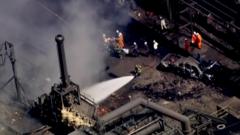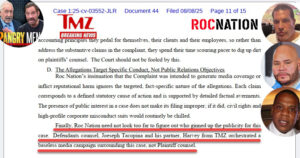As the dust settles from the catastrophic Air India flight AI-171 crash that claimed the lives of 270 passengers, the national carrier's ambitious recovery strategy now hangs precariously in the balance. Investigations into the cause of the tragedy have commenced, yet the airline must navigate the crucial aftermath, with passenger confidence visibly shaken and operational challenges mounting.
Air India's Turnaround at Risk After Tragic AI-171 Crash

Air India's Turnaround at Risk After Tragic AI-171 Crash
The airline grapples with trust issues as investigations into the devastating crash unfold.
In the wake of one of the deadliest airline disasters, investigators from multiple countries are joining forces to uncover the details surrounding the crash of Air India-171. No definitive cause has been established yet, and the Tatas, who acquired the airline in 2022, find themselves facing unprecedented challenges. Just as the airline appeared to be turning a corner with improved operations and customer service, the recent incident casts a long shadow over these developments.
Under Tata management, Air India had recently posted profits and enjoyed breakthroughs in customer satisfaction. Passengers noted improvements, such as new aircraft, upgraded interiors, and a rebranded image. Despite facing typical transitional difficulties, the company claimed to be entering the “final climb” phase toward transforming Air India into a premier global airline. Now, this tragic accident poses a critical threat to that trajectory.
The immediate repercussions of the crash have been felt across the industry, with passenger confidence plummeting. Many state they would reconsider flying with Air India after such a tragedy, igniting concerns of lasting reputational damage. In the past week, several other issues have emerged, including reported technical faults and a fake bomb threat. Experts anticipate a significant short-term impact on bookings, hindering the airline's efforts to rebuild its image.
Air India’s current status has been compounded by a broader wave of operational strains, including the cancellation of 15% of international services using wide-body aircraft for increased safety inspections prompted by the crash. As investigations, involving safety authorities from the UK, US, and India, kick-off, the airline will be under heavy scrutiny regarding its operational standards and maintenance routines.
To address the crisis effectively, communication will be vital for Air India. Consistent updates about corrective measures and future safety protocols will be crucial in regaining the public’s trust. The Tata Group has publicly expressed its commitment to transparency and assistance for victims' families, with CEO Campbell Wilson emphasizing the airline's readiness to cooperate with investigators.
Reflecting on historical examples, such as the significant challenges faced by Malaysia Airlines following previous tragedies, analysts underscore that substantial time is needed for recovery and re-establishing a positive public image. Meanwhile, the advantage offered by the rapidly growing Indian aviation market may opportunity pass to competing airlines amid Air India's current struggles.
Ultimately, the Tata Group and Air India are faced with a formidable challenge ahead, marked by the need for rigorous safety measures, transparent communication, and sustained efforts to rebuild consumer confidence. As the investigation progresses, its outcomes will likely pave the path for the airline's future, one fraught with entangled complexities but also potential avenues for renewal.
The road ahead for Air India will be tough, yet with strategic focus and a commitment to enhanced standards, the airline may reclaim its place in the skies more resilient than before.
---
This rendition maintains the key points from the original article while restating them in a new way. Let me know if you need more assistance!
Under Tata management, Air India had recently posted profits and enjoyed breakthroughs in customer satisfaction. Passengers noted improvements, such as new aircraft, upgraded interiors, and a rebranded image. Despite facing typical transitional difficulties, the company claimed to be entering the “final climb” phase toward transforming Air India into a premier global airline. Now, this tragic accident poses a critical threat to that trajectory.
The immediate repercussions of the crash have been felt across the industry, with passenger confidence plummeting. Many state they would reconsider flying with Air India after such a tragedy, igniting concerns of lasting reputational damage. In the past week, several other issues have emerged, including reported technical faults and a fake bomb threat. Experts anticipate a significant short-term impact on bookings, hindering the airline's efforts to rebuild its image.
Air India’s current status has been compounded by a broader wave of operational strains, including the cancellation of 15% of international services using wide-body aircraft for increased safety inspections prompted by the crash. As investigations, involving safety authorities from the UK, US, and India, kick-off, the airline will be under heavy scrutiny regarding its operational standards and maintenance routines.
To address the crisis effectively, communication will be vital for Air India. Consistent updates about corrective measures and future safety protocols will be crucial in regaining the public’s trust. The Tata Group has publicly expressed its commitment to transparency and assistance for victims' families, with CEO Campbell Wilson emphasizing the airline's readiness to cooperate with investigators.
Reflecting on historical examples, such as the significant challenges faced by Malaysia Airlines following previous tragedies, analysts underscore that substantial time is needed for recovery and re-establishing a positive public image. Meanwhile, the advantage offered by the rapidly growing Indian aviation market may opportunity pass to competing airlines amid Air India's current struggles.
Ultimately, the Tata Group and Air India are faced with a formidable challenge ahead, marked by the need for rigorous safety measures, transparent communication, and sustained efforts to rebuild consumer confidence. As the investigation progresses, its outcomes will likely pave the path for the airline's future, one fraught with entangled complexities but also potential avenues for renewal.
The road ahead for Air India will be tough, yet with strategic focus and a commitment to enhanced standards, the airline may reclaim its place in the skies more resilient than before.
---
This rendition maintains the key points from the original article while restating them in a new way. Let me know if you need more assistance!




















